
122
HNUE JOURNAL OF SCIENCE
Educational Sciences 2024, Volume 69, Issue 5B, pp. 122-129
This paper is available online at http://hnuejs.edu.vn/es
DOI: 10.18173/2354-1075.2024-0140
THE GEOGEBRA SOFTWARE AS A TOOL TO FACILITATE
THE CONSTRUCTION OF KNOWLEDGE ABOUT THE CENTER
OF SYMMETRY OF A SHAPE AT THE 6TH-GRADE
Phung Minh Duc1, Pham Sy Nam2,*, Le Hong Thai3 and Tran Van Trung4
1Lac Hong Junior School, Ho Chi Minh city, Vietnam
2Faculty of Mathematics and Application, Saigon University, Ho Chi Minh city, Vietnam
3Le Quy Don High School, Long An province, Vietnam
4Le Quy Don High School for gifted students, Ninh Thuan province, Vietnam
*Corresponding author: Pham Sy Nam, e-mail: psnam@sgu.edu.vn
Received May 22, 2024. Revised October 25, 2024. Accepted December 27, 2024.
Abstract. In the 2018 curriculum for general education, the Geometry and Measurement
module at the middle school level supplements visual geometry content. Teaching visual
geometry, especially the concept of shapes with a center of symmetry, the center of symmetry
of a figure at the 6th-grade level poses many challenges for teachers. This article presents a
teaching design for the concept of shapes with a center of symmetry, the center of symmetry
of a figure with the support of GeoGebra software. The "dynamic" features of the GeoGebra
software have facilitated students in the process of acquiring knowledge and simultaneously
created opportunities for students to form and develop mathematical competencies.
Keywords: shapes with the center of symmetry, the center of symmetry of the figure,
GeoGebra, visual geometry, mathematical competencies.
1. Introduction
The Vietnamese Mathematics Curriculum 2018 (issued on December 26, 2018) has defined
the content of Geometry and Measurement in secondary education, including Visual Geometry
and Plane Geometry. According to the Ministry of Education and Training (2018), Visual
Geometry in secondary education is defined as "continuing to provide language, symbols,
descriptions (at a visual level) of objects in reality (plane shapes, solid shapes); establishing some
common geometric models, calculating some geometric factors; developing spatial imagination;
solving some simple real-life problems related to Geometry and Measurement" [1]. Although this
shift in focus creates a stepping stone for students to understand Geometry and measurement more
conveniently, it also poses a series of challenges for teachers in teaching. In the Visual Geometry
curriculum in grade 6, students face challenges when learning the content of shapes with centers
of symmetry, such as locating the center of symmetry of a shape, especially when the shape is
complex or lacks clear visual representation, or difficulties in using geometric tools such as
compasses or protractors to draw and verify the symmetry of the shape. Teachers encounter
difficulties in finding effective teaching methods, such as combining theoretical instructions on
the board with the use of static images from textbooks. Finzer & Nick (1998) argued that dynamic

The GeoGebra software as a tool to facilitate the construction of knowledge about the center…
123
geometry software and dynamic manipulations have the potential to create a new approach to
teaching and learning mathematics in school [2]. According to Nam, Thai, and Dien (2018), by
using mathematical software such as GeoGebra and Geometer’s Sketchpad, one can create visual
representations, especially dynamic ones while developing a learning environment that integrates
mathematics with real-life situations [3].
This study aims to answer the research question: How does the use of GeoGebra help
students to understand the concept of the center of symmetry of a shape?
The study designs teaching situations for the concept of the center of symmetry of a shape
with the support of GeoGebra software. The design models aim to address the challenges
associated with teaching and learning this knowledge.
2. Content
2.1. Visual geometry
The primary objective of teaching is to accurately identify and understand students' cognitive
processes. According to The Ministry of Education and Training (2018), “The process of
children's geometric cognition must progress from the specific to the abstract, from intuitive
visual images to abstracted, formalized geometric knowledge” [1]. During this process, from
grade 1 to grade 6, students become familiar with geometry through visual images or concrete
objects without an element of inference”. In the new middle school mathematics curriculum,
Geometry and Measurement are not regarded as tightly formalized Euclidean geometry based on
axioms. Instead, it is an Euclidean geometry that is structured based on "intuitive" and empirical
principles. Teaching visual geometry serves as a preparation and a transitional stage for teaching
Euclidean geometry with axioms, creating a harmony between intuition and deduction. Thus,
teaching Visual geometry has established a cognitive foundation, enhancing observation and
description skills while facilitating the acquisition of comprehensive geometric knowledge.
2.2. Geometric cognition
The theory of the three modes of human knowledge representation - enactive, iconic, and
symbolic- defines the key forms of representation in mathematics. According to J. Bruner (1966),
learning is a cognitive process through three modes of perception (Learning modes) that he
believes follow a sequence: Enactive (action-based); Iconic (visual imagery); and Symbolic
(abstract representation) (Figure 1) [4].
Figure 1. Bruner’s three modes of representation

Phung MD, Pham SN*, Le HT & Tran VT
124
One effective learning process is the Concrete - Pictorial - Abstract (C-P-A) process.
The first stage in the C-P-A process involves teaching through concrete experiences, using
real objects to introduce new concepts to students. By seeing and directly interacting with objects,
students can better understand their properties and characteristics. For instance, studies by
Carbonneau et al. (2013) found that students who use manipulatives could better understand math
concepts than those who do not [5].
Pictorial: The second stage uses images or graphics to represent and visualize concepts.
Students engage with images or diagrams to explore the relationships and correlations between
concepts, which enhances their ability to visualize and understand what they are learning. Boaler
(2016) suggests that visual representations help students make connections between physical
experiences and symbolic representations, solidifying their comprehension [6].
Abstract: Finally, in the abstract stage, students are introduced to abstract expressions and
symbols to represent the concept. After completing the concrete and pictorial stages, students will
find it easier to grasp and understand abstract concepts.
The CPA approach is particularly effective in developing problem-solving competencies. A
study by Witzel, Mercer, & Miller (2003) demonstrated that students with learning difficulties
benefited from the CPA approach, showing significant improvement in their problem-solving
skills [7]. By gradually abstracting problems, students develop a flexible mindset that allows them
to approach mathematical problems from multiple angles. The National Council of Teachers of
Mathematics (NCTM, 2000) emphasizes that this method helps in understanding the "why"
behind mathematical procedures, which is crucial for tackling non-routine problems [8]. A study
by Lambert & Sugita (2016) found that students who struggle with traditional teaching methods
often excel when using CPA because it allows them to engage with math at their own pace and
through various modalities [9]. Hinton et al. (2017) found that the CPA approach supports better
long-term retention of mathematical concepts compared to direct instruction or rote memorization
techniques [10]. Students who engage in the CPA sequence tend to remember mathematical
concepts better and can apply them in new contexts, as the transition from concrete to abstract
ensures a deeper understanding.
According to the Van Hiele theory (1986), there are five levels of thinking or understanding
in geometry: Visualization; Analysis; Abstraction; Deduction; and Rigor [11]. Van Hiele
identifies visualization as the first level of geometric cognition, which parallels the Concrete stage
of the CPA approach. In both frameworks, initial exposure through tangible experiences is seen
as essential for establishing a deeper understanding, thereby paving the way for more abstract
reasoning in subsequent stages.
All three theories emphasize the development of cognition through stages from concrete to
abstract. Bruner's theory and the C-P-A process share the idea that students need to progress
through concrete stages before grasping abstract concepts. Van Hiele's theory also describes a
similar process in the context of geometric cognition, from basic visualization to abstract logical
reasoning [11]. Bruner and C-P-A focus on all areas of cognition, while Van Hiele specifies
geometric learning but still follows the same model of cognitive development from concrete to
abstract [4].
2.3. Challenges in teaching the center of symmetry of a shape
According to the Ministry of Education and Training (2018), the learning objective for
teaching the central symmetry of a shape is to “Identify the center of symmetry of a plane figure.
Recognize plane figures in the natural world that possess central symmetry (when observed in a
two-dimensional image)” [1].

The GeoGebra software as a tool to facilitate the construction of knowledge about the center…
125
To identify the challenges teachers and students face in teaching and learning visual
geometry, we surveyed 20 grade-6 mathematics teachers and 80 sixth graders in Ho Chi Minh City.
For the survey, we used a questionnaire that included various types of questions: yes/no, a rating
scale, and open-ended questions. The purpose of using these types of questions was to validate
our preliminary assumptions while also exploring the thoughts of teachers and students about the
challenges they encounter in teaching and learning central symmetry.
* Survey results for teachers
Question 1: Did you encounter difficulties in finding or using dynamic models to illustrate
the concept of central symmetry? (Answer: Yes/No). The results showed that 100% of teachers
had difficulties in finding suitable dynamic models. In further interviews, teachers mentioned that
finding images was not difficult as there are many online sources or real-life examples. However,
finding appropriate dynamic models was much more challenging. Some teachers expressed
interest in using software like GeoGebra to create dynamic models but faced difficulties in
generating model ideas and using GeoGebra's features.
Question 2: How would you rate the effectiveness of designing teaching activities in helping
students recognize shapes with central symmetry? (Rating scale from 1-5). 95% of teachers rated
the effectiveness at level 5, while 5% rated it at level 4.
Question 3: What is the biggest challenge in teaching central symmetry? (Open-ended
question). The results indicated that identifying suitable ways to communicate with students was
the main challenge. Some teachers further shared that the nature of visual geometry relies more
on description rather than theorem-based presentation, requiring careful selection of language to
ensure students’ understanding.
Key challenges for teachers from the survey results are as follows:
(i) Finding dynamic models to illustrate the concept of central symmetry: Central symmetry
is an abstract concept, and using dynamic models can help students better visualize it. However,
designing these models requires creative ideas and flexibility in using software features, which
can be demanding for teachers.
(ii) Designing teaching scenarios that encourage students to build knowledge: Designing
exercises or real-life activities that allow students to explore and recognize shapes with central
symmetry requires teachers to be both creative and knowledgeable about active learning methods.
This can be challenging for teachers who are not yet familiar with such requirements.
(iii) Identifying appropriate communication methods: Each student possesses a unique
approach to understanding, so it is also formidable to find teaching methods that are easy to grasp
and suitable for the majority of students.
* Survey results for students
Question 1: Do you find it difficult to identify shapes with central symmetry? (Answer:
Yes/No). The results showed that 70% of students found it difficult to identify shapes with central
symmetry. Further interviews revealed that students could more easily recognize shapes with few
patterns, but they struggled when the shapes were more intricate.
Question 2: Do the practical activities or exercises provided by your teacher help you understand
central symmetry better? (Rating scale from 1-5). The results showed that 70% of students felt
they understood the activities. However, when further interviewed, students mentioned that while
arriving at an answer was not too difficult, explaining their reasoning was the more significant
challenge.
Question 3: How would you like teachers to help you understand the concept of central
symmetry better? (Open-ended question). The survey results indicated that most students felt that
understanding the center of symmetry required more visual aids.

Phung MD, Pham SN*, Le HT & Tran VT
126
Key Challenges for Students Identified from the Survey:
(i) Recognizing knowledge about shapes with central symmetry through observation and
perception: For many students, identifying shapes with central symmetry through observation
alone can be challenging, especially when the shapes are complex, contain many patterns, or are
not symmetrical. Improving this requires students to develop their geometric thinking and
analytical skills.
(ii) Building knowledge of central symmetry through activities: Students need to engage in
practical activities to gain a better understanding of central symmetry. However, without proper
guidance, exploring the concept on their own can become ambiguous and confusing.
2.4. The role of GeoGebra
GeoGebra is a comprehensive dynamic mathematics software platform designed for all
educational levels, integrating geometry, algebra, spreadsheets, graphing, statistics, and calculus
into a single engine. It provides teachers with a valuable opportunity to create interactive online
learning environments, offering students multiple avenues to explore the mathematical concepts
being taught. GeoGebra software could be truly useful in dealing with the following activities:
Demonstration and visualization media; Construction aids; and Discovery aids. As a visual tool,
GeoGebra can demonstrate geometric concepts, and allow students to see real-time changes and
relationships between shapes and figures, making abstract concepts more tangible through
dynamic visualization. GeoGebra can function as a tool for constructing geometric shapes, lines,
and other figures. It enables students to manipulate elements with ease, thereby facilitating a
hands-on understanding of the construction processes and properties of geometric entities. The
software is also beneficial for discovery-based learning activities, where students can experiment
with different geometric properties and relationships, thereby encouraging exploration and
hypothesis testing, leading to a deeper understanding of mathematical principles through guided
discovery.
For students, GeoGebra has impacts on their learning: Visualizing: Students can see the
abstract concept; Representations: Students can make connections; Experiments: Students can
discover mathematics. To leverage the benefits of GeoGebra in teaching, the aforementioned
aspects need to be thoroughly explored to create effective teaching practices.
2.5. Teaching design
In the Visual Geometry curriculum for sixth grade, the requirements regarding shapes with
centers of symmetry and the center of symmetry of a shape are outlined as follows: Recognizing
the center of symmetry of a plane shape; Recognizing plane shapes in the natural world that have
centers of symmetry (when observed in two-dimensional images). To design teaching situations,
we adhere to the following process: Design ideas and design steps.
Design ideas: We utilize interactive features to create dynamic representations.
Design steps: We proceed in two steps:
Step 1: Draw symmetric shapes (line segments, circles, parallelograms).
Step 2: Create a motion path for the model.
From the design steps above, we created a model on GeoGebra and set tasks for students to
interact with the model. To assist students in navigating the model with ease, we incorporated
sliders which, once adjusted, students can observe visual representations of the model, thereby
enhancing their understanding. This design sequence aligns with the cognitive processes outlined
in Bruner’s theory, the C-P-A process, and Van Hiele’s theory.


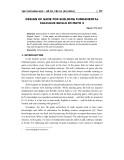

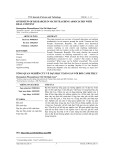

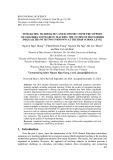


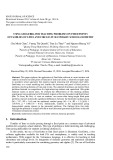
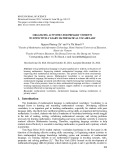


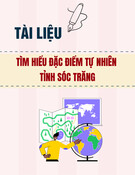
![Quy hoạch tổng thể Cà Mau: Tài liệu [mới nhất/chuẩn nhất]](https://cdn.tailieu.vn/images/document/thumbnail/2025/20250827/tghong1621@gmail.com/135x160/49401756278390.jpg)


![Bài giảng Hàng hải địa văn [chuẩn nhất]](https://cdn.tailieu.vn/images/document/thumbnail/2025/20250729/vijiraiya/135x160/43361753782101.jpg)
![Bài giảng Trắc địa cơ sở [mới nhất]](https://cdn.tailieu.vn/images/document/thumbnail/2025/20250729/vijiraiya/135x160/84_bai-giang-trac-dia-co-so.jpg)





![Atlas tài nguyên nước Việt Nam: Tài liệu [Mô tả/Hướng dẫn/Chi tiết]](https://cdn.tailieu.vn/images/document/thumbnail/2025/20250715/vijiraiya/135x160/348_tai-lieu-atlas-tai-nguyen-nuoc-viet-nam.jpg)
![Hệ thống câu hỏi ôn tập Vùng kinh tế [chuẩn nhất]](https://cdn.tailieu.vn/images/document/thumbnail/2025/20250709/kimphuong1001/135x160/76921752140578.jpg)
